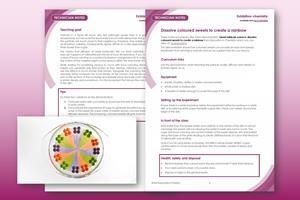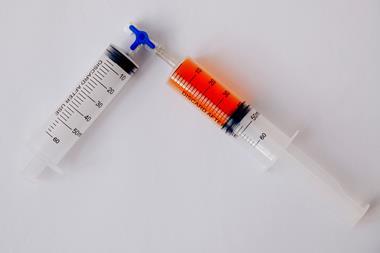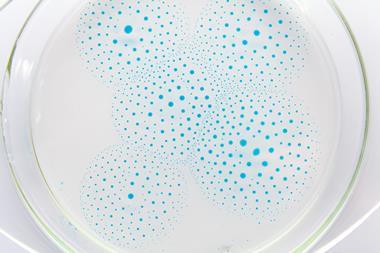-

Download this
Technician notes as MS Word or pdf to help set up and do this experiment.
View and download more Exhibition chemistry demonstrations
Get started
Watch a demonstration of this experiment and download the technician notes from the Education in Chemistry website: rsc.li/3Y6eMbz
When we introduce the particle model we can use some classic experiments to get learners to consider the arrangement and motion of particles in solids, liquids and gases. We might ask students to compress loaded syringes so that they can see and feel how surprisingly hard it is to squeeze a liquid. Or we might ask them to add food colouring to water and watch it spread out to illustrate that particles are always moving even if we don’t stir the liquid. The latter experiment can be frustratingly slow however, because the particles are moving randomly in all directions so it can take a few days for a small amount of food colouring in a beaker of water to mix uniformly. Thankfully, a little sugar can create some bulk motion, and when coloured sweets dissolve, they make very intriguing patterns.
Kit
- M&Ms, Smarties, Skittles or similar coloured sweets
- White or transparent plate or shallow dish
- White paper
- A beaker of water, enough to cover the base of the dish
Preparation
Ensure there is a white backdrop below the experiment either by working in a white dish or by placing white paper beneath a glass dish. Place your sweets around the edge of the dish.
Health, safety and disposal
- Remind learners they cannot eat in the lab and shouldn’t taste their rainbow.
- Pour used solutions down a foul-water drain.
- Dispose of solids in the general waste.
In front of the class
Add water from the beaker slowly and carefully to the centre of the dish to almost submerge the sweets without allowing the water to swish around too much. The sugar and food colouring around the outside of the sweet dissolve, sink and spread along the base of the plate leading to clearly defined bands of colour that tend not to blend with one another.
Note if you’re using M&Ms or Smarties, the effect will be slower; Skittles’ sugary centres seem to move more quickly than the chocolatey centres of M&Ms and Smarties.
Tips
Try these two variations on this demonstration:
- Compare warm with cool water to show how the rate of dissolution increases in warm water.
- Demonstrate the importance of sugar to generate the effect by swapping some of the sweets for sugar cubes or sweets whose coloured shells have already dissolved. The remaining, coloured sweets still give sharp bands of colour.
When first observing this experiment some teachers thought the motion and formation of the distinct colour bands might be associated with the charges on the dyes, but it’s actually density driven (thanks to Tom Kuntzleman for his ChemEdX blog about this). You can demonstrate this by placing a few sweets in emptied teabags or light mesh pouches and hanging them in a bigger, taller water trough or aquarium. Learners can watch as the coloured solutions sink to the base of the container before creeping along the bottom.
Tips
Try these two variations on this demonstration:
- Compare warm with cool water to show how the rate of dissolution increases in warm water.
- Demonstrate the importance of sugar to generate the effect by swapping some of the sweets for sugar cubes or sweets whose coloured shells have already dissolved. The remaining, coloured sweets still give sharp bands of colour.
When first observing this experiment some teachers thought the motion and formation of the distinct colour bands might be associated with the charges on the dyes, but it’s actually density driven (thanks to Tom Kuntzleman for his blog about this). You can demonstrate this by placing a few sweets in emptied teabags or light mesh pouches and hanging them in a bigger, taller water trough or aquarium. Learners can watch as the coloured solutions sink to the base of the container before creeping along the bottom.
Teaching goal
Particles in the air at room temperature typically have (root mean square) speeds of approximately 300–400 metres per second. However, the particles don’t travel far before bumping into a neighbour and changing direction, which is why we don’t smell a bottle of perfume opened at arm’s length at the speed of sound. Particles in a liquid still move very fast (although slower than in a gas) at room temperature, but because the liquid state is much more dense than the gaseous one, the particles are much closer to their neighbours. Therefore, they barely get to move at all before colliding. Consequently, liquids diffuse at a rate approximately 100,000 times slower than a gas.
This means that diffusion of small molecules, like our food colouring and sugar, typically happens at millimetres per minute at room temperature. If you carefully add a drop of food colouring or a crystal of potassium manganate(VII) to a larger beaker, the motion of the material might not be obvious within the time frame of a lesson.
While waiting for something obvious to occur with food colouring alone, coloured sweets can generate bulk fluid motion as they dissolve, meaning your learners can see the effects in much shorter time frames. Alongside the colouring the sugar also dissolves, which increases the local density of the solution. The denser solution then sinks to the bottom of the container and spreads along the base until it meets fluid of a similar density and momentum. It is this movement that leaves the coloured bands in the dish.
More resources
- Help students to visualise diffusion of gas particles with the Let’s get fizzical demonstration.
- Continue the sweet theme with the article, Spoiling our funfetti and associated chromatography practical for 11–14 learners, or use this demonstration featuring a lollipop to teach redox.
- Link to careers and watch this video to see how senior science manager Paul uses chemistry in his job at British Sugar.
Declan Fleming
Downloads
Dissolve coloured sweets to create a rainbow technician notes
Handout | PDF, Size 0.14 mbDissolve coloured sweets to create a rainbow technician notes
Editable handout | Word, Size 0.45 mb













































No comments yet